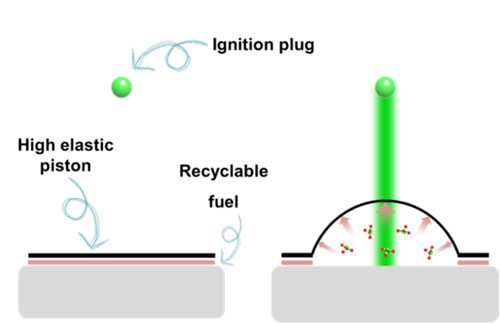| Posted: May 16, 2014 | |
Graphene nanomotor mimics internal combustion engine |
|
| (Nanowerk Spotlight) Efficient and perhaps autonomous molecular motors play an essential part in many visionary goals of nanotechnology, just like electric motors can be found in many appliances today. These nanomachines could perform functions similar to the biological molecular motors found in living cells, activities like transporting and assembling molecules, or facilitating chemical reactions by pumping protons through membranes. | |
| Although most nanomotor applications are still part of futuristic scenarios, there already is a fast-growing body of nanotechnology research that is dedicated to molecular machinery; and the results of this very early-day nanomachine research are spectacular: well-designed molecules or supramolecules show different kinds of motion – fueled by different driving forces such as light, heat, or chemical reactions – resulting in molecular shuttles, molecular elevators and rotating nanoscale motors. | |
| While most of these nanomotors are powered by quantum or, in most cases, catalytic chemical processes, the nanoscale equivalent of conventional internal heat engines that are so prevalent in our daily life has been missing. The exception being the prototype of such a nanoscale single-ion heat engine is currently being constructed by a team in Germany. | |
| In new work coming out of the National University of Singapore (NUS), researchers suggest a new type of ultrathin graphene engine which mimics an internal combustion engine system. | |
| "Our graphene engine consists of only a few parts – functionalized graphene for high-elastic piston, chemisorbed chlorine trifluoride molecules for recyclable high-power volume changeable actuator, and laser light as the 'ignition plug' – which would make it simple to work with," Barbaros Özyilmaz, an Assistant Professor in the Department of Physics at NUS, tells Nanowerk. "This is the first time anyone has used graphene for this type of motor." | |
| The results have been published in the April 28, 2014 online edition of Nano Letters ("Nanometer Thick Elastic Graphene Engine"). | |
| This is how the engine works: Several layers of chemisorbed CIF3 films are sandwiched between single layers of graphene, supported by a silicon substrate, are exposed to a 532 nm laser beam. This leads to an explosion-like increase in pressure due to a rapid volume expansion of the CIF3 molecules and delaminates graphene from the substrate in an upward blister-like bulge. After the laser is turned off, graphene goes back to its original flat state because the high reactivity of CIF3 molecules chemisorb back onto the graphene. | |
 |
|
| Schematics of graphene engine. (Image: Özyilmaz Lab, NUS) | |
| "The rapid increase in pressure followed by the volume expansion and contraction under the graphene sheet are equivalent to the explosion and motion of the piston of an internal combustion engine," explains Özyilmaz. "Key to the performance of this graphene-based engine is that the high pressure between the substrate and graphene can be sustained due to its high Young's modulus, gas impermeability, and high adhesion energy." | |
| The internal pressure of the blister is estimated to be about 10 MPa per expansion cycle of the engine. The working speed is extremely fast – less than 0.001 seconds per cycle. Even after 10,000 cycles, the graphene engine did not degrade, proving exceptional reliability. | |
| The team also notes that the blister size is easily controllable by modifying the ignition parameters. | |
| And, compared to our life-size combustion engines, this graphene engine does not generate any by-products. | |
| "Another compelling factor is that we do not need too specific a working condition, so for varied applications, this is a viable engine for nanomachines," says Özyilmaz. | |
| He notes that the bulging motion of this graphene nanoengine can be used as a pump or valve for nanofluidic applications. The device could be easily integrated into various applications by combining MEMS or NEMS techniques to transfer the generated force to each of the components. "So, consequently, the next stage would be to make and study this simple application of the nanoengine." | |
 By
Michael
Berger
– Michael is author of three books by the Royal Society of Chemistry:
Nano-Society: Pushing the Boundaries of Technology,
Nanotechnology: The Future is Tiny, and
Nanoengineering: The Skills and Tools Making Technology Invisible
Copyright ©
Nanowerk LLC
By
Michael
Berger
– Michael is author of three books by the Royal Society of Chemistry:
Nano-Society: Pushing the Boundaries of Technology,
Nanotechnology: The Future is Tiny, and
Nanoengineering: The Skills and Tools Making Technology Invisible
Copyright ©
Nanowerk LLC
|
|
|
Become a Spotlight guest author! Join our large and growing group of guest contributors. Have you just published a scientific paper or have other exciting developments to share with the nanotechnology community? Here is how to publish on nanowerk.com. |
|
